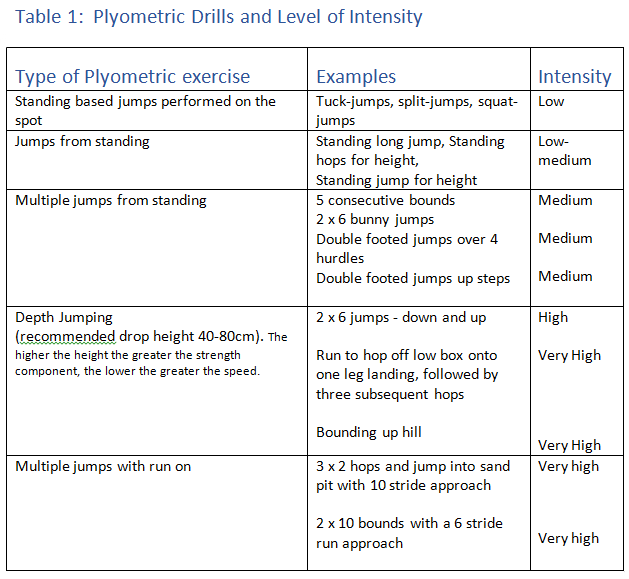400m and 400m hurdles Strength Training
The development of strength and, particularly, power is a key element in the armoury of a 400m runner as they strive to maintain form throughout the race.
Momentum coaches generally encourage all athletes we coach to undertake training to improve their strength and conditioning. (Find out about our coaching here.)
Developing strength power (the ability to overcome a resistance as quickly as possible) is a key element in the armoury of a 400m runner. Note the work described here is broadly the same for short distance sprinters - the additional endurance needed for the 1-lap runner is attained from other parts of the training regime.
How to specifically strength train
Momentum coaches do this with a combination of weights and plyometric work.
Here are some possible suitable weights exercises, although you'll want to think about what you wish to achieve and what your current weaknesses are when building a program.
- Cleans
- Squats and Squat Jumps
- Calf Raises
- Deltoid Exercises for arm drive
The first three multi-joint exercises are great at developing explosive power and what’s known as triple extension at the ankle, knee and hip – something that happens when you power from one stride to the next when running, for example.
To make weights exercises even more specific it can be an idea to do them one leg at a time (unilaterally). Such exercises would include single leg squats, split squats and lunges. This somewhat obviously reflects how we run. It’s of our opinion that these unilateral exercises are great choices for an athlete who already has good all-round strength.
You can learn a lot more on our Weight Training pages. In the meantime, here's one of our instructional videos on how to do Cleans properly.
Video Cleans Weight Lifting. How to lift a great Clean to develop power and strength.
So how do you plan your weight training to improve your sprinting?
There are a huge number of ways that strength training can be planned (known as periodisation), here’s an example:
At the start of winter training high numbers of reps could be done to build a base. Workouts at this time of the year would typically be something like 4 sets of 10 reps on many exercises (8-10). The weight lifted would be at a medium intensity. As the winter progresses you should increase the weight and reduce the reps, perhaps aiming for around 3 x 6 by February with a heavy/very heavy weight.
Why the base?
The base period is not really for fitness purposes but because these types of sessions are good for what’s known as hypertrophy (building of muscle). However, if you are already well-muscled for the event you are doing, then it is advisable to do lower rep numbers from earlier on in your training year in order to improve the power output of the muscle you already have and to not overly increase their size.
The finishing touches…
The finishing touches are added to your weight training plan as the season nears and these can involve alternating high-speed-low -weight sets (e.g. 3 x 6 on a very light weight) with very heavy weight sets with low reps (e.g. 3 x 3 at 90% of 1 rep max).
Plyometrics
Plyometrics are jumping exercises, such as hops and squat jumps, and they like weights increase power. (For more see Strength and Mobility Drills section within running.)
What are plyometric exercises?
Plyometrics are based on the fact that a concentric (shortening) muscular action is much greater if it immediately follows an eccentric (lengthening) action of the same muscle. It’s a bit like stretching out a coiled spring to its fullest extent and then letting it go. Immense levels of energy will be released in the split second the spring recoils. Plyometric exercises develop this recoil or more technically the stretch/reflex capacity in a muscle. With regular exposure to this training stimulus muscles will become better at transferring more quickly and powerfully from the eccentric to the concentric phase – so boosting running and jumping power.
Here is a brief video for a calf plyometric exercise that we call Tiggers (you have to be bouncy!)
Video Tiggers - Plyometric Calf exercise for Speed. Reactive calf explosiveness to reduce contact time.
It is a good idea to build up the number of plyometric exercises that you do gradually over a number of weeks as they can be intense and your body will take a while to get used to them. Some drills will take more effort and require more skill than others.

Photo Plyometric Drills and Level of Intensity
Credit Richard Holt
Please note that a lower intensity plyometric exercises are not by definition less beneficial then the higher intensity ones and all the types of drills in the table will potentially boost performance. What’s key to them is the speed at which the stretch/reflex occurs. It’s always best to emphasise this component over distance and height gained – these will improve over time and with regular plyometric training.
Plyometic training can be carried out throughout the year, but you should avoid doing too much near to competitions to allow your legs to be as fresh as possible for when you compete.
